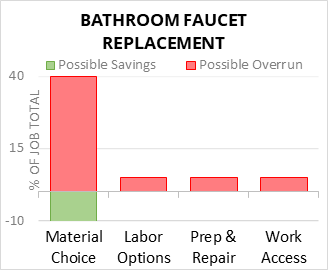In many households, the problem isn’t as costly as you think – there are various DIY methods to remedy the problem. Replacing a bathroom faucet can be relatively easy, provided you have the right tools and know-how. In this article, we’ll discuss the cost of replacing a bathroom faucet, depending on the type of faucet you have and the material it’s made from.
How much does the bathroom faucet installation cost?
Changing a bathroom faucet can be a do-it-yourself project, but some plumbing work requires professional help. You might have to move existing plumbing parts or run new lines to accommodate the new faucet. It could take up to two hours, and professional plumbers charge between $45 and $200 per hour. A handyman can do some faucet installation jobs for a fraction of the cost. Moreover, handymen can recommend skilled contractors who can complete the job quickly and efficiently.
The cost of bathroom faucet installation varies depending on the style and material of the faucet. While a basic faucet with a few features might cost $20-$60, luxury faucets can reach up to $1,000+. The materials used for the installation project also affect the overall price. If you’re looking for a faucet with luxury materials, it will cost you around $2800. The final cost will depend on your personal preferences and location.
Why is my faucet dripping?
One of the first things you should check when you suspect a leak in your bathroom faucet. You should turn off the water supply to the faucet by turning the shutoff valves beneath the sink. You can then check the faucet’s drain pipe and look under the sink for leaks. The leak may sometimes originate from the faucet’s pop-up rod. If you’ve located the leak on the side opposite the drain, you can try repairing the threads with Teflon tape. If the water still drips, you should try replacing the faucet.
A leaking faucet is an inconvenient problem that will waste a lot of water. Fortunately, the problem is not as difficult as it seems. It can be easily fixed with a quick trip to your local hardware store. Most hardware stores carry faucet replacement parts. Bring along the old ones to ensure that you buy exact replicas.
How do I fix a leaking old bathroom sink?
The most important step in fixing a leaking faucet is to turn off the water supply. If you do not, water may spill out of the sink, flooding the bathroom. Shutoff valves are located under the sink. Turn them counterclockwise to stop the flow of water. If the valves are not under the sink, shut off the water supply from the main line. If you notice water coming out, turn the faucet back on to see whether the leak is coming from the handle.
Turn off the water supply to the sink by turning off the main valve located underneath the sink. This can be done with a water meter. If you work with an older faucet, the water supply may still be running. If this is the case, the water valve might be stuck or not be turnable. To open the valve, remove the decorative cap covering the faucet handle. Then, unscrew the screw holding the handle and remove it from the faucet.
Can a dripping faucet increase your water bill?
A dripping faucet increases your water bill by wasting water. Each gallon you use is counted towards your bill. In other words, a dripping faucet wastes money every time it leaks. In addition to costing you money, the leak also leads to mold growth. Mold thrives in water collections, so if you’re not careful, your dripping faucet will eventually result in mold growth. The mould will not only ruin your faucet but also be a health hazard.
To determine if your dripping faucet is the source of the water leak, you should inspect your faucet regularly. You can visually tell if it is dripping by looking for water puddles around the faucet. To check if you can identify the source, you can also try wrapping a towel around the faucet handle or hanging a plastic bag underneath it to catch the water leak.
How much does it cost for a faucet replacement?
The average cost to replace a bathroom faucet is $130 to $350, including labor and materials. The cost of a new faucet varies widely depending on the installation’s type, style, and complexity. Fortunately, most plumbers are more than happy to come and install your new faucet, so you don’t have to worry about the price of the new fixture after all. However, the faucet installation cost can vary significantly depending on where you live and whether or not you need to drill into the countertop.
If you have the right tools and basic home improvement skills, you can probably replace your bathroom faucet. However, if you want a professional plumber to perform the installation, you should hire a licensed professional. The plumber will charge you for labor and materials; the job can take anywhere from one to seven hours. In addition to the installation, you’ll need to prepare the work area to prevent water damage, remove the old faucet, and install the new one.
Average faucet installation cost on average, you can expect to pay $246 for a new bathroom sink faucet installation. The typical range is between $158 and $339. Kitchen faucets will cost between $260 and $480 for labor. The cost of replacing a bathtub faucet is between $150 and $400 for just the labor. In general, higher price ranges are a result of higher flow rate on these faucets than on bathroom sink faucets.
Is it bad if a faucet drips?
A dripping bathroom faucet may indicate that a washer is worn out, the valve seat is damaged, or something is wrong with the plumbing. Call a plumber if you do not know how to fix a dripping faucet. Plumbing professionals are highly trained to handle all plumbing issues and can quickly solve even the most complicated of issues. A professional plumber will also know exactly what to check and replace.
Most homeowners don’t know how to fix a leaking faucet, so it’s best to call a plumber. In the case of a leaky bathroom faucet, something has likely weakened the seal. In these cases, mineral deposits build up over time, and the valve seat will become corroded. If this happens, the seal will no longer work effectively, and the faucet will begin to drip. To fix a dripping bathroom faucet, call a plumber today. They will be able to fix the problem in 30 minutes or less.
Dripping faucets also waste large amounts of water. A single leaky faucet can waste 3,000 gallons of water annually, which is harmful to the environment and the local water supply. In addition, a dripping faucet can cause water restrictions in your area and lead to a higher water bill. Water bills are increasing as a result of leaking faucets. One leaky bathroom faucet can waste up to 3,000 gallons of water yearly.
How do I install a new bathroom faucet?
Before installing a new bathroom faucet, you must ensure the sink flange is properly aligned. Some faucets have plastic or rubber gaskets that can be placed over the drain hole. If the faucet doesn’t come with a plastic gasket, you can use a plumber’s putty snake to attach it to the sink. Apply clear silicone to the mounting nut and tighten it with your basin wrench.
Next, you will need to assemble the faucet. Many bathroom faucets come with pre-assembled parts for the bathroom sink. Read the instructions for the faucet you’re installing to ensure you have everything needed. You can also prop up the countertop upside down on top of the vanity before you start assembling it. For larger countertops, you can prop them up on the floor. Make sure you hold the water lines steady when you turn the wrench.
Next, you will need to connect the cold and hot water supply lines to the faucet. Then, you will need to attach the two parts to the wall using flared fittings and compression nuts. Be sure to use Teflon tape to prevent leakage through the threads. Then, screw the inlet shanks using the supplied hot and cold water lines. After that, tighten the nuts with a wrench and finger, and replace the faucet. Within one or two hours, you should be able to replace a simple faucet if you have some basic home improvement skills.
When should faucets be left dripping?
One of the biggest problems with plumbing is that pipes in unheated areas are particularly prone to break, including your attic, garage, or exterior wall for a faucet replacement. If your water pipes are exposed to cold weather, they can burst, spilling gallons of water at a time. Broken pipes can make a huge mess in your home, ruining your furniture and causing expensive repairs.
One good time to leave your faucet dripping is during the coldest part of winter. This will keep your pipes from freezing and relieve the pressure on them. You can keep the thermostat at 55 degrees Fahrenheit or open cabinet doors to let warm air enter your plumbing. Another good time to leave your faucet dripping is when the temperature is below freezing. Remember to turn the temperature down as low as possible, but keep in mind that you don’t want to freeze your pipes – it’s better to have a few extra drips in the winter than to freeze them.
If the dripping faucet is a ceramic-disk model, you’ll need new neoprene seals. To replace the seals, you can buy replacement parts or a kit that includes everything you need. Before you begin, however, make sure you know what part you need to replace. Then, take the new parts to the store. When putting it all back together, it’s best to use the proper screwdriver to remove the handle.
Conclusion
A countertop or bathroom sink faucet mount, by far, is the most common type of fixture that fits in pre-drilled holes in the bathroom countertop, vanity, or sink. Bathroom faucets are most of the first things you can see when looking for a new house. Double-check the existing faucet in the bathroom sink and bathtub faucets to see if it needs a new faucet.
Faucet replacement is mostly needed in bathroom faucets, bathtub faucets, kitchen sink faucets, and some of the existing faucets. To do the faucet installation, you can call for a plumber to do the pipes replacement job. Ask for the price of the installation labor for the kitchen or bathroom sink faucets.



